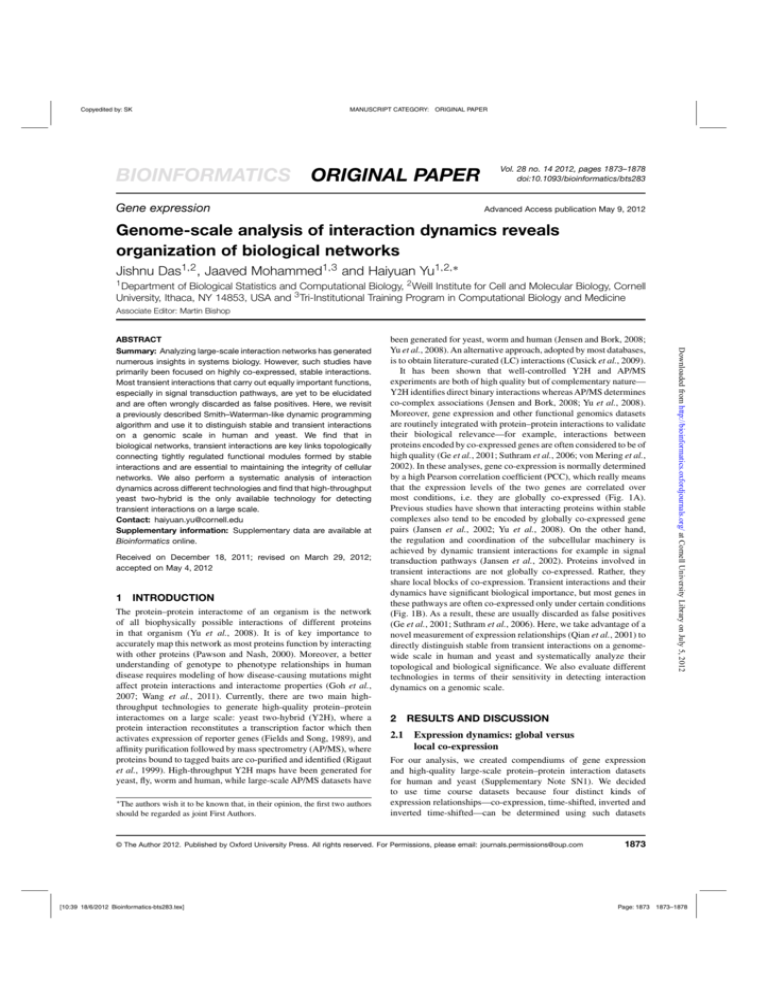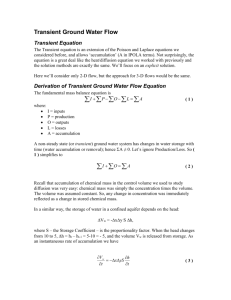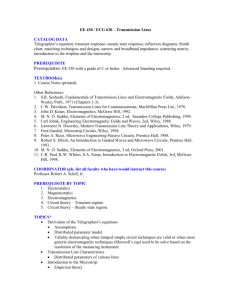
Copyedited by: SK
MANUSCRIPT CATEGORY: ORIGINAL PAPER
BIOINFORMATICS
ORIGINAL PAPER
Gene expression
Vol. 28 no. 14 2012, pages 1873–1878
doi:10.1093/bioinformatics/bts283
Advanced Access publication May 9, 2012
Genome-scale analysis of interaction dynamics reveals
organization of biological networks
Jishnu Das1,2 , Jaaved Mohammed1,3 and Haiyuan Yu1,2,∗
of Biological Statistics and Computational Biology, 2 Weill Institute for Cell and Molecular Biology, Cornell
University, Ithaca, NY 14853, USA and 3 Tri-Institutional Training Program in Computational Biology and Medicine
1 Department
Associate Editor: Martin Bishop
Received on December 18, 2011; revised on March 29, 2012;
accepted on May 4, 2012
1
INTRODUCTION
The protein–protein interactome of an organism is the network
of all biophysically possible interactions of different proteins
in that organism (Yu et al., 2008). It is of key importance to
accurately map this network as most proteins function by interacting
with other proteins (Pawson and Nash, 2000). Moreover, a better
understanding of genotype to phenotype relationships in human
disease requires modeling of how disease-causing mutations might
affect protein interactions and interactome properties (Goh et al.,
2007; Wang et al., 2011). Currently, there are two main highthroughput technologies to generate high-quality protein–protein
interactomes on a large scale: yeast two-hybrid (Y2H), where a
protein interaction reconstitutes a transcription factor which then
activates expression of reporter genes (Fields and Song, 1989), and
affinity purification followed by mass spectrometry (AP/MS), where
proteins bound to tagged baits are co-purified and identified (Rigaut
et al., 1999). High-throughput Y2H maps have been generated for
yeast, fly, worm and human, while large-scale AP/MS datasets have
∗ The authors wish it to be known that, in their opinion, the first two authors
should be regarded as joint First Authors.
been generated for yeast, worm and human (Jensen and Bork, 2008;
Yu et al., 2008). An alternative approach, adopted by most databases,
is to obtain literature-curated (LC) interactions (Cusick et al., 2009).
It has been shown that well-controlled Y2H and AP/MS
experiments are both of high quality but of complementary nature—
Y2H identifies direct binary interactions whereas AP/MS determines
co-complex associations (Jensen and Bork, 2008; Yu et al., 2008).
Moreover, gene expression and other functional genomics datasets
are routinely integrated with protein–protein interactions to validate
their biological relevance—for example, interactions between
proteins encoded by co-expressed genes are often considered to be of
high quality (Ge et al., 2001; Suthram et al., 2006; von Mering et al.,
2002). In these analyses, gene co-expression is normally determined
by a high Pearson correlation coefficient (PCC), which really means
that the expression levels of the two genes are correlated over
most conditions, i.e. they are globally co-expressed (Fig. 1A).
Previous studies have shown that interacting proteins within stable
complexes also tend to be encoded by globally co-expressed gene
pairs (Jansen et al., 2002; Yu et al., 2008). On the other hand,
the regulation and coordination of the subcellular machinery is
achieved by dynamic transient interactions for example in signal
transduction pathways (Jansen et al., 2002). Proteins involved in
transient interactions are not globally co-expressed. Rather, they
share local blocks of co-expression. Transient interactions and their
dynamics have significant biological importance, but most genes in
these pathways are often co-expressed only under certain conditions
(Fig. 1B). As a result, these are usually discarded as false positives
(Ge et al., 2001; Suthram et al., 2006). Here, we take advantage of a
novel measurement of expression relationships (Qian et al., 2001) to
directly distinguish stable from transient interactions on a genomewide scale in human and yeast and systematically analyze their
topological and biological significance. We also evaluate different
technologies in terms of their sensitivity in detecting interaction
dynamics on a genomic scale.
2
2.1
RESULTS AND DISCUSSION
Expression dynamics: global versus
local co-expression
For our analysis, we created compendiums of gene expression
and high-quality large-scale protein–protein interaction datasets
for human and yeast (Supplementary Note SN1). We decided
to use time course datasets because four distinct kinds of
expression relationships—co-expression, time-shifted, inverted and
inverted time-shifted—can be determined using such datasets
© The Author 2012. Published by Oxford University Press. All rights reserved. For Permissions, please email: journals.permissions@oup.com
[10:39 18/6/2012 Bioinformatics-bts283.tex]
Downloaded from http://bioinformatics.oxfordjournals.org/ at Cornell University Library on July 5, 2012
ABSTRACT
Summary: Analyzing large-scale interaction networks has generated
numerous insights in systems biology. However, such studies have
primarily been focused on highly co-expressed, stable interactions.
Most transient interactions that carry out equally important functions,
especially in signal transduction pathways, are yet to be elucidated
and are often wrongly discarded as false positives. Here, we revisit
a previously described Smith–Waterman-like dynamic programming
algorithm and use it to distinguish stable and transient interactions
on a genomic scale in human and yeast. We find that in
biological networks, transient interactions are key links topologically
connecting tightly regulated functional modules formed by stable
interactions and are essential to maintaining the integrity of cellular
networks. We also perform a systematic analysis of interaction
dynamics across different technologies and find that high-throughput
yeast two-hybrid is the only available technology for detecting
transient interactions on a large scale.
Contact: haiyuan.yu@cornell.edu
Supplementary information: Supplementary data are available at
Bioinformatics online.
1873
Page: 1873
1873–1878
Copyedited by: SK
MANUSCRIPT CATEGORY: ORIGINAL PAPER
J.Das et al.
A
Expression level
Global co-expression
Conditions
B
Conditions
Fig. 1. Cartoon depiction of protein–protein interaction dynamics. (A) Gene
expression profiles for two proteins that are highly correlated under all
conditions indicating a stable or globally co-expressed interaction. (B) Two
contiguous blocks of significant co-expression indicate this pair of proteins
is transiently interacting or locally co-expressed.
(Qian et al., 2001). Details of the biological significance of each
of these four categories can be found in Supplementary Note SN2.
As the cell is in a different state at each of these time points, we are
in fact measuring expression under different intracellular conditions.
All datasets are carefully normalized to remove potential noise
(Irizarry et al., 2003; Johnson et al., 2007; Luscombe et al., 2003; Yu
et al., 2007b). We also compiled high-quality large-scale protein–
protein interaction datasets for human and yeast spanning both
high-throughput technologies—Y2H and AP/MS. We consolidated
high-quality binary interactions in the literature from various
databases (Supplementary Note SN3). Although traditionally these
LC interactions are considered to be of high quality, recent studies
have shown that many of them, especially those supported by
only one publication, in fact tend to be false positives (Cusick
et al., 2009). To remove unreliable interactions from our analysis,
we carefully compiled comprehensive sets of high-quality binary
LC interactions supported by multiple publications (named ‘LCmultiple’) for human and yeast. High-quality LC co-complex
associations were obtained from MIPS (Mewes et al., 2011)
for yeast and Reactome (D’Eustachio, 2011) for human—two
databases generally considered as gold standards for complexes
in the corresponding organisms (Jansen et al., 2002; Lage et al.,
2007).
From these datasets, we first calculated the PCC for expression
profiles corresponding to interacting protein pairs in the high-quality
interaction datasets described above. For a pair of gene expression
profiles, PCC reports the global correlation of expression levels
across all conditions (Qian et al., 2001). A PCC value close to
one indicates the pair of genes is globally co-expressed (Fig. 1A),
whereas values close to zero indicate random, uncorrelated
2.2
Interaction dynamics: stable versus transient
Next, to explore interaction dynamics across different technologies,
we compared how successful different experimental techniques were
in detecting stable and transient interactions. In agreement with
previous studies, stable interactions within subcellular complexes
show a strong enrichment of proteins encoded by globally coexpressed genes (Figs. 2A & B, Supplementary Figure SF1). On
the other hand, although statistically significant, the enrichment of
these globally co-expressed pairs is much less for binary interactions
from both large-scale Y2H and LC sources. This lack of global
co-expression has often been used as an argument to suggest that
high-throughput Y2H interactions are of low quality (Ge et al., 2001;
Suthram et al., 2006; von Mering et al., 2002). However, a recent
study applied orthogonal assays to experimentally confirm that these
binary interactions are in fact highly reliable (Yu et al., 2008).
Figures 2C and D shows that in both human and yeast, Y2H is the
only technology consistently able to identify transient interactions
significantly more than random expectation. Surprisingly, binary
interactions from the literature are not enriched with transient
ones. Given the sociological biases within interactions from the
literature (Cusick et al., 2009; Yu et al., 2008), there might be many
compounding factors for this result. Stable interactions are easier
to recapitulate under different experimental conditions, whereas
transient interactions can only be tested under specific conditions.
Therefore, transient interactions are more likely to be considered
as false positives and not reported in the literature. In addition,
in the post-genomic era, many candidate interaction partners are
Downloaded from http://bioinformatics.oxfordjournals.org/ at Cornell University Library on July 5, 2012
Expression level
Local co-expression
expression patterns. We find that the different interaction datasets
for both human and yeast are significantly enriched for global
co-expression as opposed to random gene pairs (Figs. 2A &
B). Since PCC is a linear correlation coefficient and certain coexpression relationships could be non-linear, we also used the
maximal information coefficient (MIC) (Reshef et al., 2011) to
explore global expression dynamics of the different interaction
datasets in human and yeast. MIC belongs to a class of maximal
information-based nonparametric exploration (MINE) statistics and
has been shown to be very robust in detecting a wide range of
associations both linear and not (Reshef et al., 2011). Using MIC,
we revalidate the global expression dynamics captured by PCC–all
the high-quality interaction datasets in both human and yeast have
significantly enriched global co-expression as opposed to random
gene pairs (Supplementary Figure SF1). Interacting protein pairs
that have PCC greater than a certain cutoff (Supplementary Note
SN4) are defined as stable interactions.
However, gene pairs that are only co-expressed under certain
conditions could have low and non-significant global PCC/MIC
values. These often go undetected in the global nature of the
computation, making global correlation an ineffective method
for identifying condition-specific characteristics of transient
interactions. To define dynamic co-expression relationships, we
employed a Smith–Waterman-like dynamic programming algorithm
as described previously (Qian et al., 2001). For each pair of
genes and their expression profiles, this algorithm calculates local
expression-correlation scores (LES) to find subsets of conditions
with correlated expression levels (Fig. 1B). Interacting proteins that
do not pass the global PCC cutoff but have high LES are defined as
transient interactions (see Section 4).
1874
[10:39 18/6/2012 Bioinformatics-bts283.tex]
Page: 1874
1873–1878
Copyedited by: SK
MANUSCRIPT CATEGORY: ORIGINAL PAPER
Genome-scale analysis of interaction dynamics
first identified based on gene expression and other genomic features
favoring selection of stable interactions over transient ones. This
result further highlights the importance of high-throughput Y2H
because it is the only technology available to detect transient
interactions, confirming that different protein interaction detection
technologies capture different modes of biochemical interactions
(Jensen and Bork, 2008; Yu et al., 2008).
2.3
Biological significance of transient interactions
To assess the biological significance of transient interactions as
defined by our algorithm, we computed functional similarity
of protein pairs involved in these interactions. We find that
transient interactions are significantly enriched for proteins with
similar functions and the fold enrichment is comparable to that
of stable interactions in both human and yeast (Supplementary
Figure SF2.). These results confirm the validity of our definition
of transient interactions. We therefore provide the first method
to systematically detect transient interactions on a genomic scale.
Although our method might miss certain transient interactions,
especially extremely transient ones that are virtually impossible to
distinguish from random, our results confirm that those detected
by our method are high quality and share significant functional
similarity.
A good example of transient interactions identified by Y2H is
the interaction between Sfb2 and Sec23. This interaction has been
confirmed in vivo (Peng et al., 2000). Sec23 is a subunit of the
COPII complex required for the budding of transport vesicles from
endoplasmic reticulum (Miller et al., 2003). SFB2 has a 56%
sequence identity with SEC24, an essential component of COPII
involved in cargo selection (Miller et al. 2003). Overexpression
of SFB2 can rescue the sec24 null mutant cells (Kurihara et al.,
2000). Furthermore, it has been suggested experimentally that Sfb2
may recognize different export signals from those of Sec24 and
may be used under non-normal growth conditions (Miller et al.,
2003; Peng et al., 2000). These results agree with the expression
dynamics revealed by our new analysis—SFB2 and SEC23 are only
co-expressed during stress response (Fig. 3A).
Downloaded from http://bioinformatics.oxfordjournals.org/ at Cornell University Library on July 5, 2012
Fig. 2. (A, B) Enrichment of PCC of co-expression of interacting proteins (detected by different technologies) as opposed to random gene pairs in human
and yeast respectively. (C, D) Comparison of transient interactions detected per technology in human and yeast, respectively. The dashed line indicates the
overall average detection of transient interactions.
2.4 Transient interactions key in maintaining
network integrity
Traditionally, in network analysis, the focus has been on nodes.
Hubs are crucial in maintaining the integrity of biological networks
(Albert et al., 2000; Barabasi and Albert, 1999; Jeong et al., 2000).
Interaction networks have two broad categories of hubs. Date hubs
have low average PCC with their interactors and hold the key in
maintaining the integrity of cellular networks, while party hubs have
1875
[10:39 18/6/2012 Bioinformatics-bts283.tex]
Page: 1875
1873–1878
Copyedited by: SK
MANUSCRIPT CATEGORY: ORIGINAL PAPER
J.Das et al.
Downloaded from http://bioinformatics.oxfordjournals.org/ at Cornell University Library on July 5, 2012
Fig. 3. (A) The expression profiles of SFB2 and SEC23 (co-expression only in the final yellow block). (B, C) Transient interactions in human are enriched in
“date hubs”. These have previously been shown to be vital in forming important topological links between stable functional modules. (D) Transient interactions
in human and yeast have a significantly higher betweenness value–they hold the key in maintaining the integrity of cellular networks. (E, F) Characteristic path
length as a measure of network connectivity after successive removal of edges of the network. Each data point represents the removal of a fixed percentage of
overall nodes of the graph from each interaction type. Random removal occurs on all interactions in the network, which may include other interactions that are
still uncategorized as transient or stable. Removal of transient interactions increases path length more sharply than disturbing random or stable interactions.
1876
[10:39 18/6/2012 Bioinformatics-bts283.tex]
Page: 1876
1873–1878
Copyedited by: SK
MANUSCRIPT CATEGORY: ORIGINAL PAPER
Genome-scale analysis of interaction dynamics
3 CONCLUSIONS
Here, we utilize a previously described Smith–Waterman-like
dynamic programming algorithm to segregate transient interactions
from stable complexes on a genomic scale directly from gene
expression data. For the first time, we distinguish their biological
roles and show that although transient interactions are currently
underexplored, they perform key biological functions and are
essential to maintaining the integrity of cellular networks. Moreover,
we find that Y2H is currently the only technology that is
able to determine transient interactions on a large scale. Our
findings are likely to generate significant interest in designing
experiments to detect transient interactions to further explore their
properties.
4 METHODS
4.1
Calculating PCC, MIC and LES
PCC was calculated in a massively parallel Java program (Supplementary
Note SN6) using the Parallel Java framework (Kaminsky, 2010). MIC
was calculated using a Java implementation provided by Reshef et al
(2011). Transient interactions for human and yeast were identified with a
similar Parallel Java implementation of a Smith–Waterman-like dynamic
programming algorithm (Supplementary Note SN7) to calculate LES (Qian
et al., 2001). A summarization of the total count and technology-specific
count of stable and transient interactions is listed in Supplementary Tables
ST1 and ST2.
4.2
Calculating betweenness and functional similarity
Edge betweenness was calculated using the Girvan–Newman algorithm
(Girvan and Newman, 2002). Functional similarity was studied using total
ancestry measure—a metric that takes the entire biological process tree
and calculates the association of each gene with a biological process.
For each protein pair query, it computes what fraction of all possible
protein pairs that share the same set of Gene Ontology (Ashburner et al.,
2000) biological pathway terms as the query pair (Yu et al., 2007a).
The calculations are performed using a massively Parallel Java program
(Kaminsky, 2010).
The implementations and datasets are available through our
supplementary website: http://www.yulab.org/Supp/IntDynamics/.
Funding: JD is supported by the Tata Graduate Fellowship. JM
is supported in part by NIH Training Grant 1T32GM083937,
Tri-Institutional Training Program in Computational Biology &
Medicine, awarded by the National Institute of General Medical
Sciences. HY is supported by US National Institute of General
Medical Sciences. This work was funded by US National Institute
of General Medical Sciences grant R01 GM097358 to HY.
Conflict of Interest: none declared.
REFERENCES
Albert,R., et al. (2000) Error and attack tolerance of complex networks, Nature, 406,
378–382.
Ashburner,M., et al. (2000) Gene ontology: tool for the unification of biology. The Gene
Ontology Consortium. Nat. Genet., 25, 25–29.
Barabasi,A.L. and Albert,R. (1999) Emergence of scaling in random networks, Science,
286, 509–512.
Cusick,M.E., et al. (2009) Literature-curated protein interaction datasets. Nat. Methods,
6, 39–46.
D’Eustachio,P. (2011) Reactome knowledgebase of human biological pathways and
processes. Methods Mol. Biol., 694, 49–61.
Dunn,R., et al. (2005) The use of edge-betweenness clustering to investigate biological
function in protein interaction networks. BMC Bioinformatics, 6, 39.
Fields,S. and Song, O.(1989) A novel genetic system to detect protein-protein
interactions. Nature, 340, 245–246.
Ge,H., et al. (2001) Correlation between transcriptome and interactome mapping data
from Saccharomyces cerevisiae. Nat. Genet., 29, 482–486.
Girvan,M. and Newman,M.E. (2002) Community structure in social and biological
networks. Proc. Natl Acad. Sci. USA, 99, 7821–7826.
Goh,K.I., et al. (2007) The human disease network. Proc. Natl Acad. Sci. USA, 104,
8685–8690.
Han,J.D., et al. (2004) Evidence for dynamically organized modularity in the yeast
protein-protein interaction network. Nature, 430, 88–93.
Irizarry,R.A., et al. (2003) Exploration, normalization, and summaries of high density
oligonucleotide array probe level data. Biostatistics, 4, 249–264.
Jansen,R., et al. (2002) Relating whole-genome expression data with protein-protein
interactions. Genome Res., 12, 37–46.
Jensen,L.J. and Bork,P. (2008) Biochemistry. Not comparable, but complementary.
Science, 322, 56–57.
Jeong,H., et al. (2000) The large-scale organization of metabolic networks. Nature, 407,
651–654.
Johnson,W.E., et al. (2007) Adjusting batch effects in microarray expression data using
empirical Bayes methods. Biostatistics, 8, 118–127.
Kaminsky,A. (2010) Building parallel programs: SMPs, clusters, and Java. Course
Technology, Cengage Learning, Boston, MA.
Kurihara,T., et al. (2000) Sec24p and Iss1p function interchangeably in transport vesicle
formation from the endoplasmic reticulum in Saccharomyces cerevisiae. Mol. Biol.
Cell., 11, 983–998.
Lage,K., et al. (2007) A human phenome-interactome network of protein complexes
implicated in genetic disorders. Nat. Biotechnol., 25, 309–316.
Luscombe,N.M., et al. (2003) ExpressYourself: a modular platform for processing and
visualizing microarray data. Nucleic Acids Res., 31, 3477–3482.
Mewes,H.W., et al. (2011) MIPS: curated databases and comprehensive secondary data
resources in 2010. Nucleic Acids Res., 39, D220–D224.
Downloaded from http://bioinformatics.oxfordjournals.org/ at Cornell University Library on July 5, 2012
high average PCC with their interactors and are often contained in
tightly organized modules (Han et al., 2004). We find that date hubs
have a significant propensity to be involved in transient interactions
(Figs. 3B & 3C), suggesting that these play an important role in
maintaining the integrity of the networks. To validate this result, we
compared the edge ‘betweenness’ of global and transient interactions
(Supplementary Note SN5). Edge betweenness can be used to detect
community structure within networks (Girvan and Newman, 2002).
Clusters detected by this approach tend to share similar functions
(Dunn et al., 2005). We find that transient interactions for both
human and yeast have a significantly higher betweenness than
stable interactions (Fig. 3D). This implies that transient interactions
hold the key in maintaining the integrity of the underlying cellular
network. Disrupting these will partition the interactome into disjoint
clusters, unable to perform temporally and spatially well-regulated
processes.
To further explore topological properties of transient interactions,
we examined connectivity in response to progressive edge removal
and found that selectively removing transient interactions increased
characteristic path length much more sharply than selectively
removing stable or random interactions (Figs. 3E & 3F). Biological
interactomes are small-world networks and removing a random edge
is unlikely to significantly alter connectivity, as most random edges
are not essential in maintaining network integrity (Albert et al.,
2000). However, selectively disrupting key edges disrupts network
structure and increases the characteristic path length significantly.
Since removal of transient interactions causes the sharpest increase
in path length, these are indeed critical for network integrity.
1877
[10:39 18/6/2012 Bioinformatics-bts283.tex]
Page: 1877
1873–1878
Copyedited by: SK
MANUSCRIPT CATEGORY: ORIGINAL PAPER
J.Das et al.
Miller,E.A., et al. (2003) Multiple cargo binding sites on the COPII subunit Sec24p
ensure capture of diverse membrane proteins into transport vesicles. Cell, 114,
497–509.
Pawson,T. and Nash,P. (2000) Protein-protein interactions define specificity in signal
transduction. Genes Dev., 14, 1027–1047.
Peng,R., et al. (2000) Evidence for overlapping and distinct functions in protein
transport of coat protein Sec24p family members. J. Biol. Chem., 275, 11521–11528.
Qian,J., et al. (2001) Beyond synexpression relationships: local clustering of timeshifted and inverted gene expression profiles identifies new, biologically relevant
interactions. J. Mol. Biol., 314, 1053–1066.
Reshef,D.N., et al. (2011) Detecting novel associations in large data sets. Science, 334,
1518–1524.
Rigaut,G., et al. (1999) A generic protein purification method for protein complex
characterization and proteome exploration. Nat. Biotechnol., 17, 1030–1032.
Suthram,S., et al. (2006) A direct comparison of protein interaction confidence
assignment schemes. BMC Bioinformatics, 7, 360.
von Mering,C., et al. (2002) Comparative assessment of large-scale data sets of proteinprotein interactions. Nature 417, 399–403.
Wang,X., et al. (2011) Network-based methods for human disease gene prediction. Brief
Funct Genomics, 10, 280–293.
Yu,H., et al. (2008) High-quality binary protein interaction map of the yeast interactome
network. Science, 322, 104–110.
Yu,H., et al. (2007a) Total ancestry measure: quantifying the similarity
in tree-like classification, with genomic applications. Bioinformatics, 23,
2163–2173.
Yu,H., et al. (2007b) Positional artifacts in microarrays: experimental verification
and construction of COP, an automated detection tool. Nucleic Acids Res.,
35, e8.
Downloaded from http://bioinformatics.oxfordjournals.org/ at Cornell University Library on July 5, 2012
1878
[10:39 18/6/2012 Bioinformatics-bts283.tex]
Page: 1878
1873–1878







